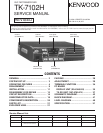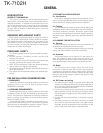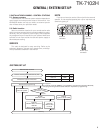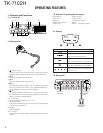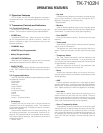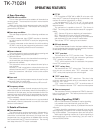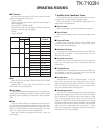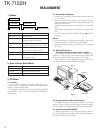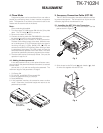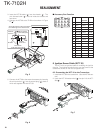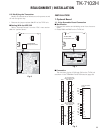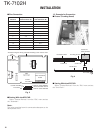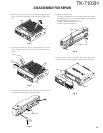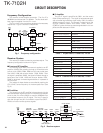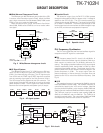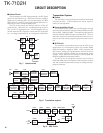TK-7102H
6
4. Scan Operating
■ SCAN start condition
Two or more channels must be added to all channels that
can be scanned. The transceiver must be in normal receive
mode (PTT off).
When you activate the key programmed to the scan ON/
OFF function, the scan starts. The indicator next to the pro-
grammed key LED blinks.
■ Scan stop condition
The scan stops temporarily if the following conditions are
satisfied.
1) A carrier is detected, then QT/DQT matches on channels
for which receive the QT/DQT is set by the programming
software.
2) A carrier is detected on the channels for which receiving
QT/DQT is not set by the programming software or when
the monitor (signalling cancel) function is activated.
■ Revert channel
The revert channel is used to transmit during scanning and
set by the programming software (KPG-70D).
1) Selected channel
The transceiver reverts to the channel before scanning or
the channel that you changed during scan.
2) Selected with talkback
The transceiver reverts to the selected channel prior to
scan initiation.
However, if a call is received on a channel other then the
selected channel and PTT is pressed before scanning re-
sume, the transceiver “talks back” on the current receive
channel.
■ Scan end
When you press the key programmed to the scan function
during scan mode, the scan ends.
The indicator next to the programmed key LED turns off.
■ Temporary delete
It is possible to delete channel temporary during scan.
When scan stops on unnecessary channel for example by in-
terference of the other party, activate the delete function (for
example press and hold the key for approximately one sec-
ond), then that channel is deleted temporarily and scan re-
start immediately.
The temporary deleted channels return to pre-set delete/
add channels, when the transceiver is turned off or the scan
function is switched off.
5. Details of Features
■ Time-out timer
The time-out timer can be programmed in 30 seconds in-
crements from 30 seconds to five minutes and off. If the
transmitter is transmitted continuously for longer than the
programmed time, the transmitter is disabled and a warning
tone sounds while the PTT button is held down. The warning
tone stops when the PTT button is released.
■ PTT ID
PTT ID provides a DTMF ANI or MSK ID to be sent with
every time PTT (connect ID at beginning of transmission, dis-
connect ID at end of transmission, or both).
You can program PTT ID “on” or “off” for each group
channel (DTMF). The contents of ID are programmed for
each transceiver.
The transceiver is capable to have ID. The format is
DTMF. The timing that the transceiver sends ID is program-
mable.
BOT : Connect ID is sent on beginning of transmission.
EOT : Disconnect ID is sent on end of transmission.
Both : Connect ID is sent on beginning of transmission
and disconnect ID is sent on end of transmission.
There is also “PTT ID” setting for each channel.
■ Off hook decode
If the Off hook decode function has been enabled, remov-
ing and replacing the microphone on the hook has no effect
for decoding QT/DQT and option signalling.
■ “TOT” pre-alert
The transceiver has “TOT” pre-alert timer. This param-
eter selects the time at which the transceiver generates
“TOT” pre-alert tone before “TOT” is expired.
“TOT” will be expired when the selected time passes
from a TOT pre-alert tone.
■ “TOT” re-key time
The transceiver has “TOT” re-key timer. This timer is the
time you can not transmit after “TOT” exceeded. After
“TOT” re-key time expired you can transmit again.
■ “TOT” reset time
The transceiver has “TOT” reset timer. This timer is the
minimum wait time allowed during a transmission that will
reset the “TOT” count.
“TOT” reset time causes the “TOT” to continue even af-
ter PTT is released unless the “TOT” reset timer has expired.
■ Clear to transpond
The transceiver waits the transpond of DTMF if channel is
busy until channel open. This feature prevents the interfer-
ence to other party.
6. Option Signalling (DTMF)
Built-in DTMF decoder is available for option signalling.
It is possible to use individual call, group call, Stun.
If the option signalling matches, a predetermined action
will occur.
If option signalling matches on a channel is set up with
option signalling, the channel LED will flash and option signal-
ling will be released. The transpond or alert tone will sound.
While option signalling matches (or if option signalling is
deactivated when you are transmitting), you can mute or
unmute QT/DQT/Carrier.
OPERATING FEATURES



